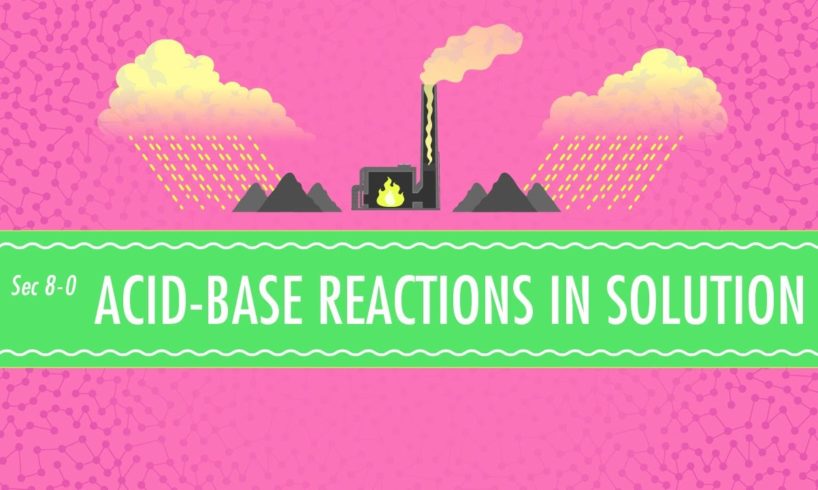
Last week, Hank talked about how stuff mixes together in solutions. Today, and for the next few weeks, he will talk about the actual reactions happening in those solutions – atoms reorganizing themselves to create whole new substances in the processes that make our world the one we know and love. This week, we focus on acids and bases and their proton-exchanging ways.
Pssst… we made flashcards to help you review the content in this episode! Find them on the free Crash Course App!
Download it here for Apple Devices: https://apple.co/3d4eyZo
Download it here for Android Devices: https://bit.ly/2SrDulJ
Table of Contents
Chemistry Can Cause Death 00:00
Acids and Bases are Complicated 02:25
Conjugate Bases 05:37
Conjugate Acids 04:48
Acid-Base Stoichiometry 06:49
Crash Course is on Patreon! You can support us directly by signing up at http://www.patreon.com/crashcourse
Want to find Crash Course elsewhere on the internet?
Facebook – http://www.facebook.com/YouTubeCrashCourse
Twitter – http://www.twitter.com/TheCrashCourse
Instagram – https://www.instagram.com/thecrashcourse/
CC Kids: http://www.youtube.com/crashcoursekids
source







Pssst… we made flashcards to help you review the content in this episode! Find them on the free Crash Course App!
Download it here for Apple Devices: https://apple.co/3d4eyZo
Download it here for Android Devices: https://bit.ly/2SrDulJ
deadmau5 scene in the video. 6:23
I might just be over thinking acids and bases but I do not understand acids and bases.
Well, socialism didn't turn the oceans to lemonade, but capitalism turned the rain into lemon juice.
I had a few questions:
For example HCl is stable but then why is it split?
And why is H2O accepting a proton?
crash course binge cause GCSEs start in 109 days and I haven't started studying
why is no one here saying their teacher sent this video to them to comprehend what were the famous acid-base reactions for online classes… wow
5:09 Hank: on the left-hand side
5:16 Hank: and on the left hand side
Me wondering why he said left and left instead of left and right: 🤔
At 10:28 in review, the first thing I read:
Chemistry can cause death
OMG, I thought I recognized the background. You are in my home town of Missoula MT!!!
The carbonic acid result spoken of at 7:20 . I dont fully get it. It has the Calcium atom become positively charged because the acid reaction from the hydrogen donating its positively charged hydrogen atoms to the Carbonate results in the positive ionization charges to be moved into the Calcium atom as a result of the reaction. Causing the calcium to be separated and replaced by Hydrogen that then further dissolves into CO2 right? Hence why it says CO30. The 0 to denote it lost its positive charge to the calcium atom?
Am I wrong?
Hank: eats lemon and says that it is very sour, he then will drink water to neutralize the flavor in his mouth
Also Hank one minute later: water is the most common acid
The extra stoichiometry from the near end…
– The question: Assuming that 1 billion (1,000,000,000) metric tons of 3% sulfur coal was burned in America every year, and all of it was converted to SO2 (sulfur dioxide), how many tons of limestone would be needed to scrub out 100% of that sulfur?
– Using both of the same equations from earlier in the video:
n(sulfur) = [(30kg/ton) × 1,000,000,000] × (1,000g/kg) × (mol/32.065g)
n(sulfur) = 30,000,000,000 × (1,000g/kg) × (mol/32.065g)
n(sulfur) = 30,000,000,000,000 × (mol/32.065g)
n(sulfur) = 935,599,563,387 mol (for 1 billion metric tons of 3% sulfur coal burnt)
– Since all of the sulfur from the burned coal is converted to SO2, 64.0638g is used for the molarity in the next equation since that is the atomic mass of SO2.
m(SO2) = 935,599,563,387 mol × (64.0638g/1 mol) × (1kg/1,000g) × (1 ton/1,000kg)
– After multiplying (935,599,563,387) mol and (64.0638g/1 mol), I simplified the last two units, (1kg/1,000g) and (1 ton/1,000kg) to (1 ton/1,000,000g) in the next part to make the equation a bit cleaner.
m(SO2) = 5,993,781,156,912g × (1 ton/1,000,000g)
OR
m(SO2) = 5,993,781,156,912g/1,000,000g
m(SO2) = 5,993,781.16 tons (to the nearest hundredth)
So, in order to scrub out 100% of the SO2 (sulfur dioxide) created when 1 billion metric tons of 3% sulfur coal was burned in the United States, you would need 5,993,781.16 (or approximately 6 million) metric tons of limestone.
I've been looking for the answers in the comment but ehhhh hahhaa
Oh my god you really are amazing🙌🙌 how did you just explained me so easily about exactly all those things I was so😵😵 confused about for such long . Thanks seems a small word 😍😍
Chemists live shorter? Source?
more informative and clear than my own chemistry teacher lol keep ur the good work
Did anyone else notice that he said left hand side to refer to both the right and left hand sides at 5:17 ?
With the conversion rate in the video, of the sulfur in 1 ton of coal reacting with 93.6 kg of limestone, 1 billion tons will react with 93.6 billion kilograms of limestone, otherwise written as 93.6 million tons, or 93,600,000 million kilograms, or 93,600,000,000,000 kilograms, or an estimated 15,600 Great Pyramids of Giza. But this is not all. Each mole of sulfurous acid will also cause 1 mole each of carbon dioxide and water vapor to be released. This equates to 935 billion moles of each, and thus 41,140,000 tons of CO2 and 16,830,000 tons of gaseous H2O. So… yeah… some pretty heavy stuff if you ask me.
(I can totally imagine my calculations being wrong, especially with all the power of ten stuff going on. Please correct me if you do find errors, thanks!)
Shout out to all of you here before the 2020 AP Chem exam online bc of COVID-19
5:36 wait… it can’t be… an Arrested Development cameo!??
Hi Dalt and Log
Can we just talk about the Alien: Isolation reference at 1:38
acids are tops, bases are bottoms. pass it on
come on, eating lemons can't be THAT bad
hi
conjugal = just conjugal = just a word.
Coal burning countries, not just US, most countries still do
Exothermic and endothermic
Are transcripts of Crash Course available? I'd love them for a reference, since I'm so poor at science. It would help me teach better. Thanks!
Hank: ”chemist die younger than the average person”
also Hank: A small price to pay for salvation
46.875 kg of limestone per ton approx
10:22 to 10:26 sums up my existence
When you watch crash course chemistry cause your teachers make you learn chem in 7th grade
your videos are literally so good. Thank you so so very much !!!!
01110380038
eat your cereal
I need things that are very useful for me in chemistry, and this is a WhatsApp number and my phone, so please send me something that helps me
He didn't say "Hey ya'll, Scott here."
I like the that joke "bases are like the anti-acid, BASically."
We also have a statue of Captain John Mullan where I live, which is also Montana but not the same place in Montana.
quit blinking.
8:43 Spaceballs reference. Love it!
3:25 Me when I end up wetting the bed due to a toilet dream